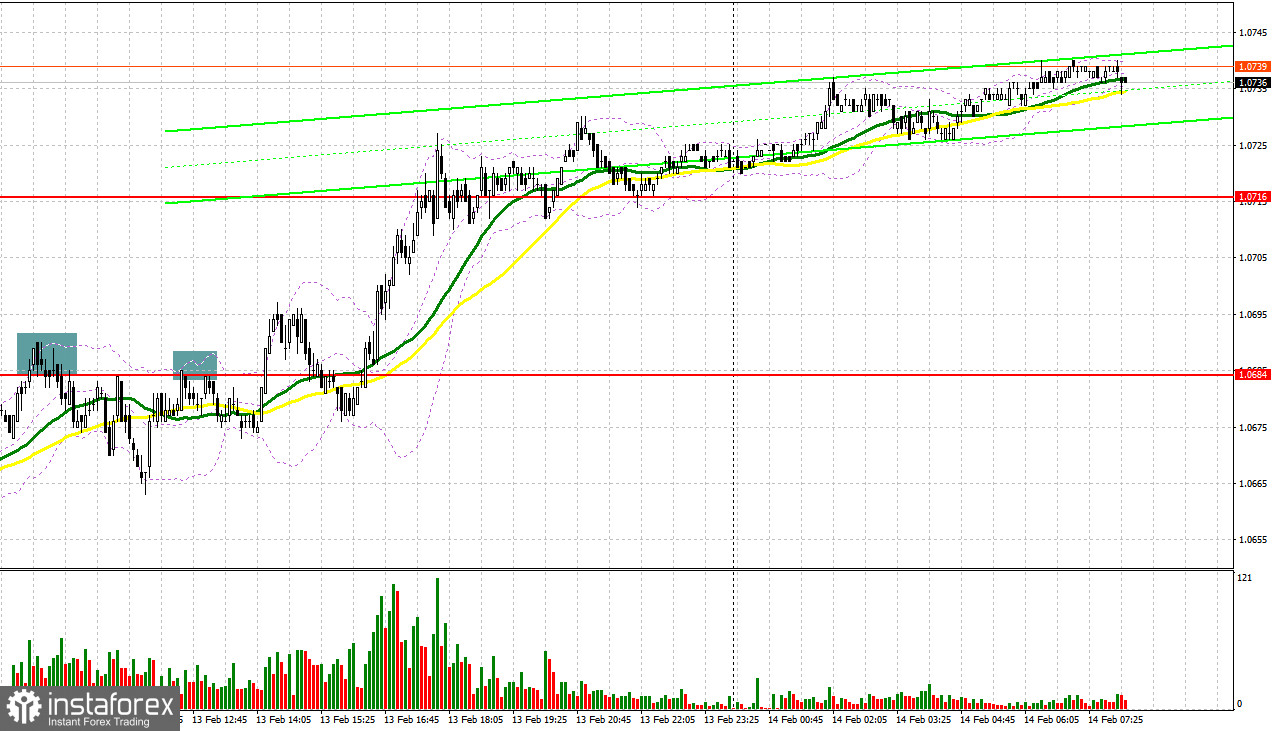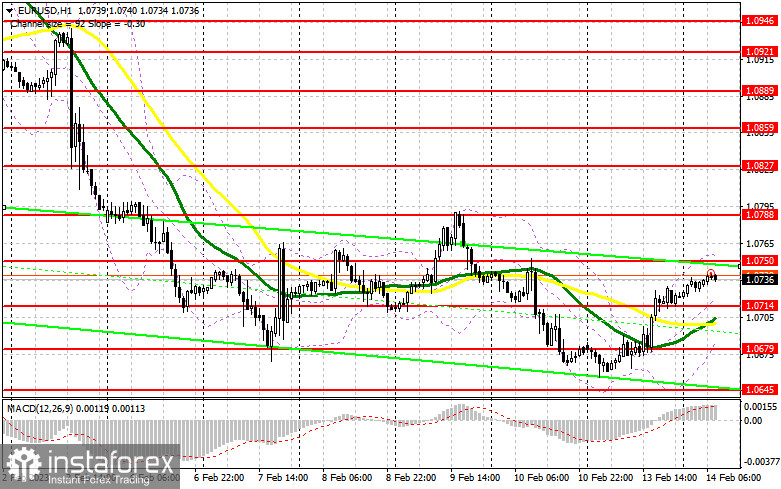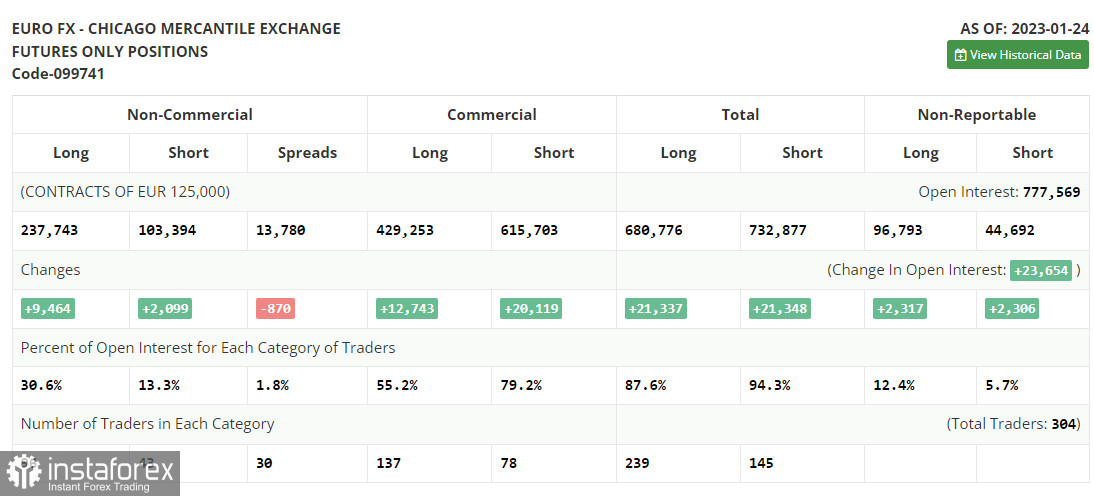Yesterday, traders received several perfect signals to enter the market. Let us take a look at the 5-minute chart to clear up the market situation. Earlier, I asked you to pay attention to the level of 1.0684 to decide when to enter the market. A jump in the first part of the day led to a false breakout of 1.0684. After that, the price rapidly dropped by more than 20 pips but failed to touch the nearest support level of 1.0645. In the second part of the day, traders received a similar signal. As a result, the pair slid by just 10 pips. After that, the price broke the level and resumed rising.

Conditions for opening long positions on EUR/USD:
Yesterday, traders locked in profits before the publication of the US inflation figures, which are slated for release today. What is more, the European Commission published quite a strong report on the eurozone economic growth. Today, in the first part of the day, the eurozone will disclose its GDP data for the fourth quarter. The data will hardly be revised. It means that the data is unlikely to affect the market and support the euro like the unemployment figures. In this light, in the first part of the day, the euro may drop to the level of 1.0714. Buyers are likely to become active at this level. Only a false breakout of this level will allow traders to open long positions with the target at 1.0750 formed on Friday. A breakout and a downward test of this level will give an additional buy signal with the target at 1.0788. However, the pair is unlikely to go above this level before the publication of the US fundamental data. A breakout of 1.0788 will affect stop orders and give an additional signal, which will boost the pair to 1.0827, where it is better to lock in profits. If the euro/dollar pair declines and buyers fail to protect 1.0714, pressure on the pair will remain intact. However, this will not mean that bulls lose control over the market. Traders will focus on the support level of 1.0697. Slightly above this level, there are bullish MAs. Only a false breakout of the level will give a buy signal. It is also possible to go long just after a bounce off the low of 1.0645 or even lower – from 1.0601, expecting a rise of 30-35 pips within the day.
Conditions for opening short positions on EUR/USD:
Traders may open short orders from 1.0750, a resistance level formed on Friday. However, they should make sure that big traders are in the market. It is unlikely that bears will be aggressive ahead of the US inflation report. Nevertheless, a false breakout of the level will be enough to launch a correction to 1.0714. A breakout and a reverse test of this level will give an additional sell signal with the target at 1.0679, which will intensify the bearish sentiment. A settlement below this level will occur only in case of negative data on the US GDP and inflation, which may show higher than expected growth. In this case, the pair will tumble to 1.0645, where it is better to lock in profits. If the euro/dollar pair increases during the European session and bears fail to protect 1.0750, bulls will remain active. In the event of this, traders should avoid selling until the price touches 1.0788, where it is possible to sell only after an unsuccessful settlement. Traders may also go short just after a rebound from the high of 1.0827, expecting a decline of 30-35 pips.

COT report
Since a technical problem in the CFTC has been settled yet. The latest COT report was published on January 24. Thus, the COT report for January 24 logged a rise in both short and long positions. Traders have significantly increased long positions following hawkish speeches of ECB policymakers. They are betting on further monetary tightening by the ECB and the Fed's dovish stance. The US regulator may reduce the pace of tightening for the second time in a row. Weak macro stats on the US economy, namely a drop in retail sales and a slowdown in inflation may force the central bank to take a pause in rate hikes to avoid any damage. This week, several central banks will hold their meetings. Their results will eventually determine the trajectory of the euro/dollar pair. According to the COT report, the number of long positions of the non-commercial group of traders increased by 9,464 to 237,743 while short positions advanced by 2,099 to 103,394. At the end of the week, the total non-commercial net position rose to 134,349 from 126,984. It appears investors believe in the upside potential of the euro. Nevertheless, they are waiting for more clues from central banks regarding interest rates. The weekly closing price grew to 1.0919 from 1.0833.

Signals of indicators:
Moving Averages
Trading is performed above 30- and 50-day moving averages, which points the balance in the market.
Note: The author considers the period and prices of moving averages on the one-hour chart which differs from the general definition of the classic daily moving averages on the daily chart.
Bollinger Bands
If the pair increases, the resistance level will be formed by the upper limit of the indicator located at 1.0750. In case of a decline, the lower limit of the indicator located at 1.0680 will act as support.
Description of indicators
- Moving average (a moving average determines the current trend by smoothing volatility and noise). The period is 50. It is marked in yellow on the chart.
- Moving average (a moving average determines the current trend by smoothing volatility and noise). The period is 30. It is marked in green on the graph.
- MACD indicator (Moving Average Convergence/Divergence - convergence/divergence of moving averages). A fast EMA period is 12. A slow EMA period is 26. The SMA period is 9.
- Bollinger Bands. The period is 20.
- Non-profit speculative traders are individual traders, hedge funds, and large institutions that use the futures market for speculative purposes and meet certain requirements.
- Long non-commercial positions are the total number of long positions opened by non-commercial
- traders.
- Short non-commercial positions are the total number of short positions opened by non-commercial traders.
- The total non-commercial net position is a difference in the number of short and long positions opened by non-commercial traders.





















